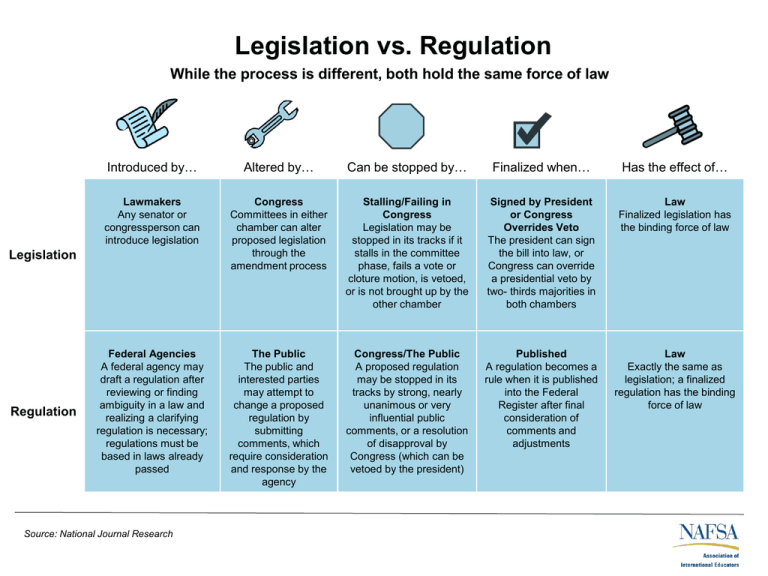What Is The Difference Between A Law And A Regulation
What Is The Difference Between A Law And A Regulation?
When it comes to legal matters, it can often be confusing to understand the various terms and concepts that are involved. One question that frequently arises is the difference between a law and a regulation. While these two terms are related and serve similar purposes, they do have distinct differences. In this article, we will explore the definition and characteristics of both laws and regulations, as well as delve into their key distinctions.
1. Laws: The Backbone of a Legal System
Definition
Laws are a set of rules that are established and enforced by the government to regulate human behavior within a society. They are created through a legislative process and are applicable to all individuals within a specific jurisdiction.
Characteristics
- Binding: Laws are legally binding and non-compliance can result in penalties or other forms of punishment.
- Authority: They are enacted by legislative bodies, such as parliaments, congresses, or other governing bodies, depending on the country.
- Formality: Laws follow a formal process and are typically written and documented.
- Scope: Laws can cover a wide range of topics, such as criminal offenses, civil matters, property rights, and more.
Example
One example of a law is the "Speed Limit Law," which sets the maximum allowable speed for vehicles on public roads. This law ensures public safety and helps prevent accidents caused by excessive speed.
2. Regulations: The Fine Details

Definition
Regulations, on the other hand, are more specific guidelines or rules that are derived from laws. They are created by government agencies or departments to provide detailed instructions for implementing and enforcing laws.
Characteristics
- Specificity: Regulations fill in the gaps left by laws and provide specific details on how to comply with the law.
- Authority: They are created by government agencies authorized to regulate specific industries or sectors.
- Flexibility: Regulations can be amended or updated more frequently compared to laws, allowing for adaptability to changing circumstances.
- Enforcement: Violation of regulations can result in penalties, fines, or other consequences depending on the specific regulations in question.
Example
For instance, the law on food safety may require restaurants to maintain hygiene standards. The corresponding regulation would provide specific guidelines on the proper storage and handling of food, periodic inspections, and other requirements to ensure compliance with the law.
3. Key Differences Between Laws and Regulations
While laws and regulations share similarities, they also have notable differences. Here are three key distinctions:
a) Source of Authority
Laws are established by legislative bodies, while regulations are created by government agencies or departments. In summary, laws come from lawmakers, while regulations come from regulators.
b) Level of Detail
Laws are broad and general, laying out overarching principles, rights, and obligations. Regulations are more specific and detailed, providing the necessary instructions and guidelines for compliance with the law.
c) Process of Change
Changing a law typically involves a complex legislative process, requiring multiple stages and approvals. Regulations, on the other hand, can be modified or updated more easily and quickly by the responsible agency, allowing for faster adaptation to evolving circumstances.
FAQs
Q: Can regulations exist without laws?
A: No, regulations are derived from laws and cannot exist independently. They are created to provide specific guidelines for implementing and enforcing the broader principles established by laws.
Q: How are regulations enforced?
A: Regulations are enforced by the government agencies or departments responsible for the specific industry or sector being regulated. These agencies have the authority to conduct inspections, issue fines, and take legal actions against violators.
Q: How often do regulations change?
A: The frequency of regulatory changes varies depending on the specific sector and governing body. Some industries with rapidly evolving technologies or significant public concerns may experience more frequent updates to regulations to address emerging issues.
Q: Can individuals influence the creation of laws or regulations?
A: Yes, individuals and organizations have the opportunity to provide input and influence the creation or modification of laws and regulations through public consultations, lobbying, and other forms of advocacy. However, the final decision-making power rests with the relevant legislative and regulatory bodies.
Conclusion
In summary, laws and regulations are both crucial components of a legal system. Laws provide the fundamental framework for governing society, while regulations offer the specific guidelines and instructions necessary for compliance. Understanding the differences between laws and regulations can help individuals navigate legal requirements and obligations more effectively.
What Is The Difference Between A Law And A Regulation? - Mspnow.org
 Image Source : mspnow.org
Image Source : mspnow.org Difference Between Act And Law | Comparison Of Definition, Features
 Image Source : www.pinterest.com
Image Source : www.pinterest.com laws pediaa marathi
Презентация "Is It Easy To Be Young ?" - скачать бесплатно
Introducing Rules And Laws - Parliamentary Education Office
 Image Source : mail.peo.gov.au
Image Source : mail.peo.gov.au Legislation Vs. Regulation
 Image Source : studylib.net
Image Source : studylib.net legislation
10 Characteristics Of Regulation, Its Laws, Functions, Types And
 Image Source : crgsoft.com
Image Source : crgsoft.com What Is The Difference Between Rules And Regulations - Pediaa.Com In
 Image Source : www.pinterest.com
Image Source : www.pinterest.com pediaa regulations
Laws Vs. Regulations And Why The Difference Matters - Indivisible
 Image Source : indivisiblesb.org
Image Source : indivisiblesb.org laws regulations vs difference matters why rules
Legislation vs. regulation. Introducing rules and laws. Презентация "is it easy to be young ?". What is the difference between rules and regulations. Pediaa regulations